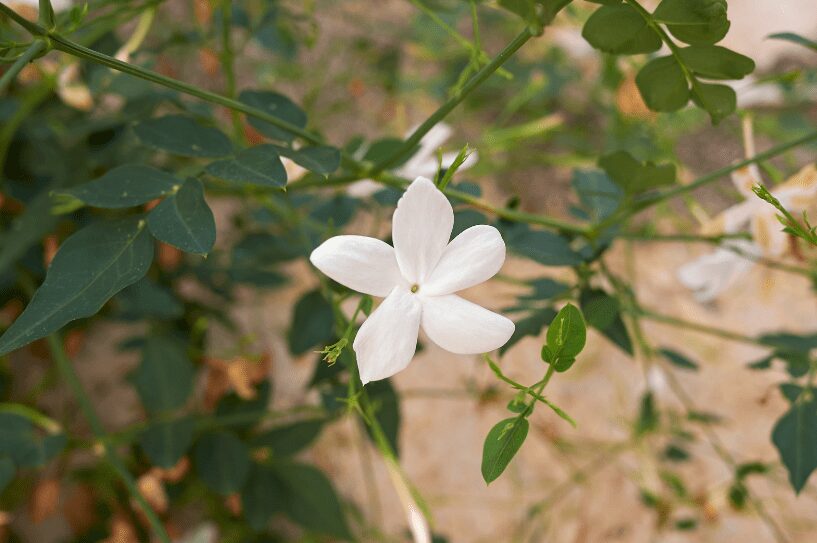
Jasminum Grandiflorum
The vine-forming species of Spanish jasmine (Jasminum grandiflorum), from which jasmine perfume is made, is indigenous to the Himalayas.
It is produced commercially in southern France, close to Nice, where flowers picked during the hottest summer months are used to make perfume.
The best time to select flowers is immediately after sunrise because morning dew would lessen their aroma.
Its aroma, unparalleled in the plant kingdom, cannot be replicated using any chemical compound alone in a lab environment.
It may not bloom every year (mild winters prevent summer blossoming), be briefly deciduous (Angelenos have little tolerance for plants that lose their leaves), demand more water than the usual vine, and require more soil well-drained than that of many of our gardens.
Other Jasmine Variants
While some varieties of jasmine are not as fragrant as those used to make perfume, others compete favorably as decorative vines and bushes.
The winter and spring flowering vine Jasminum polyanthum produces white blooms with pink undertones.
The iconic Jasminum mesnyi is currently in bloom and has arching, fountain-like stems covered in popcorn-yellow blooms that eventually turn white.
It can be trained up a trellis or planted as a hedge. Italian jasmine (Jasminum humile) blooms in the summer and fall and grows into an 8-foot-tall shrub with yellow flowers.
While angel wing jasmine (Jasminum nitidum) prefers summer heat but needs protection from the cold in the winter, Arabian jasmine (Jasminum sambac) is more suited to a coastal climate than an inland valley climate.
The lilacs (syringa) bloom irregularly in subtropical Los Angeles but consistently in Lancaster. The sweet olives (osmanthus), which need protection from the heat, are two other groups of plants notable for their fragrance.
Jasmine is a member of the olive family (Oleaceae), which also includes the familiar privet (ligustrum), ash (Fraxinus), and an olive tree.
The Descanso Gardens have a sizable display of lilacs, which ought to be just starting to blossom. They are off the main garden trails and are easily missed, so ask about their location at the Descanso entrance before visiting them.
Jasmine Bloom
Many plants are widely referred to as jasmines – or jessamines – despite being botanically unrelated to true jasmines since the term has grown synonymous with fragrant white or yellow blossoms.
At this time of year, the Carolina jessamine (Gelsemium sempervirens) produces sheets of yellow blooms. Once planted, the only water it needs in the summer is a proper soak once a month.
A shrub called orange jessamine (murraya paniculata) can bloom at any time and will do so more frequently if it receives regular fertilization.
Star jasmine is one of the most well-liked garden plants (Trachelospermum jasminoides). This plant, which is grown by taking shoot cuttings, is one that one might make a decent livelihood from producing, according to a nurseryman who once told me.
Although predominantly a ground cover and vine, star jasmine can also be grown as a shrub and even trained as a standard (small patio tree).
If not for the summer midnight scent that emanates from its unremarkable blossoms, the night-blooming jasmine (Cestrum nocturnum), which grows into an 8-foot (or larger) shrub, has little horticultural appeal.
In my humble view, Cestrum elegans, with its massive clusters of wine-red tubular blossoms, has considerably higher garden value.
Jasminoides is Latin for “like jasmine.” Each of the numerous named varieties of Gardenia jasminoides, whose aroma is similar to that of jasmine, is challenging to grow.
The white potato vine, Solanum jasminoides, climbs like jasmine and blooms all year round, even though it has no scent.
Weekly advice: February is the time to start preparing your spring garden. It’s crucial to plant in our region well before the summer heat, which can start as early as April.
Make sure the soil has had time to dry out after rain before planting partially; if you dig it out, it stays together in a big lump on your shovel, and the soil is still too wet to be planted.
Jasmine And Perfume
Jasmine is challenging to reproduce, but in the last 30 years, the fragrance and flavor house Firmenich introduced the synthetic Methyl Dihydro Jasmonate (Hedione), providing a tenacious alternative.
Ah, where would perfumery be without it?
It is rare not to find jasmine in the heart note of any great perfume.
Over five million flowers must be gathered to get 600 kilos of jasmine blossoms.
Although it’s a little expensive, in my opinion, jasmine oil is well worth the cost. Be it added to a warm bath or burned in an oil- burner, the aroma of a few drops of Jasminum grandiflorum acts as a beautiful antidepressant and relaxant.
The flowers make a calming infusion (but never take the essential oil internally). Nor do jasmine’s beneficial properties end there: mixing the essential oil with a base oil, for example, makes a soothing balm for dry or sensitive skin.






















